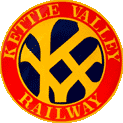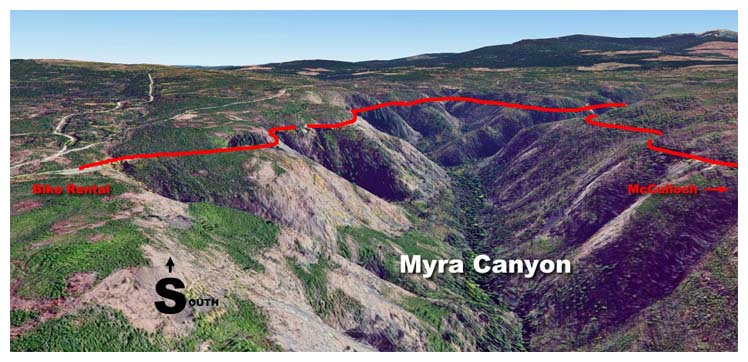
Myra Canyon East Trailhead
Kelowna British Columbia Canada
N49.803789 W119.312033
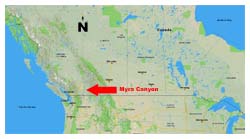
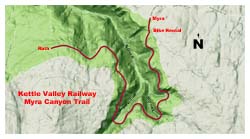
 The Kettle Valley Railway (KVR), known as "McCulloch's Wonder", was created by the Canadian Pacific Railway (CP). It wound its way across southern British Columbia over hill and dale from Hope to the Crow's Nest Pass near the border with Alberta. It is now part of the Trans-Canada Trail system. Myra Canyon became better known in 1974 through the release of the CBC (Canadian Broadcasting Corporation) television series named the "National Dream", spawned from Piere Burton's book of the same title.
The Kettle Valley Railway (KVR), known as "McCulloch's Wonder", was created by the Canadian Pacific Railway (CP). It wound its way across southern British Columbia over hill and dale from Hope to the Crow's Nest Pass near the border with Alberta. It is now part of the Trans-Canada Trail system. Myra Canyon became better known in 1974 through the release of the CBC (Canadian Broadcasting Corporation) television series named the "National Dream", spawned from Piere Burton's book of the same title.
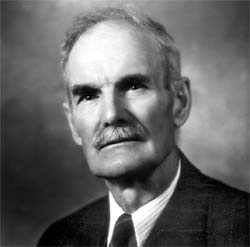 The Canadian Pacific Railway was completed across Canada on 7 November 1885 and by the 1890s construction commenced south from Sicamous on the main line towards Okanagan Landing at the north end of Okanagan Lake. Stern wheel ships plied the lake between Okanagan Landing and Pentiction thereby connecting Penticton to the outside world.
The Canadian Pacific Railway was completed across Canada on 7 November 1885 and by the 1890s construction commenced south from Sicamous on the main line towards Okanagan Landing at the north end of Okanagan Lake. Stern wheel ships plied the lake between Okanagan Landing and Pentiction thereby connecting Penticton to the outside world.
With the discovery of minerals and timber in southern British Columbia the population centers grew, bringing a demand for a southern east-west rail route across BC's sea of mountains. Because the mountain chains run roughly north-south, construction along the valleys was less costly and simpler. The American, J.J. Hill, with his Great Northern Railroad (GN) was one of the first to penetrate the region from the United States.
Shaughnessy, then head of CP, saw this as a threat to CP and commenced construction through the Crow's Nest Pass westward towards Midway. In 1901 a charter was granted for construction of the Kettle River Valley Railway (KRVR) to connect a mine at Republic, and a smelter at Grand Forks. Shaughnessy, using this charter as his legal basis, began survey work in 1910 from Midway to Penticton and the newly named Kettle Valley Railway (KVR) was born.
A year later work west of Penticton was commenced towards the Coquihalla Canyon and Hope. On 30 May 1915 the Coast-to-Kootenay connection became a reality.
KVR traffic began to dwindle in 1949 when the Hope Princeton Highway opened. By 1962 tracks through the Coquihalla had been removed. In January of 1964 the last passenger train ran from Merritt to Penticton, onto Midway, and finally into Nelson. Kettle Valley Railway passenger service was over but segments of KVR territory remained in freight service until 1989.
Shaughnessy had chosen Andrew McCulloch as the Chief Engineer for the construction of the KVR. This man, who oddly chose to name stations along the route with Shakespearean names, had to oversee many construction difficulties through this mountainous region of BC. McCulloch hiked the country to get the lay of the land, and to determine which side of a mountain to put the line, but it was subordinates who actually surveyed the grade. McCulloch usually made personal field surveys with a transit only where unusually difficult problems arose. The Quintette Tunnels in all probability were not personally located by Andrew McCulloch. There is evidence to suggest that GN engineers may have made the first location.
120 rail miles to the east of the Quintette Tunnels lies Lake Okanagan. Myra Canyon is still further east of Pentiction and is reached by a twisting rail route ascending from Okanagan Lake to nearly 4,200 feet at Myra. The Myra Canyon trail alone contains 18 trestles and 2 tunnels.
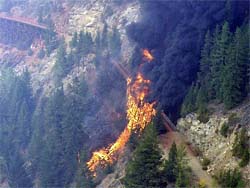 2003 was the 5th year of drought in the Okanagan Valley so a lightening struck in mid-August ignited the Okanagan Mountain Park forest fire. The fire spread many kilometres beyond its source burning for nearly a month consuming more than 200 homes in Kelowna and over 20,000 acres of forest and parkland.
2003 was the 5th year of drought in the Okanagan Valley so a lightening struck in mid-August ignited the Okanagan Mountain Park forest fire. The fire spread many kilometres beyond its source burning for nearly a month consuming more than 200 homes in Kelowna and over 20,000 acres of forest and parkland.
In the first week of September, it reached the Myra Canyon trestles and in the next few days destroyed 12 of the 16 wooden structures and damaged the two steel trestles. In addition there was damage to the trail itself, to the rock faces, and to the amenities which had been built up over the previous ten years.
The heritage value of the trestles, as recognized by the Historic Sites and Monuments Board, was key to the decision to replace the trestles. There were other reasons, however, namely the recreation and tourism values but arguably the most important consideration was the extensive community involvement in the original restoration. Reconstruction costs were covered under a Federal-Provincial Disaster Financial Assistance Agreement which provided 90 percent by the federal government and 10 percent by the province.
Although the plan called for the trestles to resemble the original structures, there was no need for the previous strength to carry trains. This meant the design had to carry only heavy construction equipment across the trestles to access all the construction sites. This new design meant the structures would have fewer horizontal stringers and fewer vertical legs in the bents, and in some cases, fewer bents.
The first trestle, number 18, was rebuilt in the fall of 2004, just one year after the fire. Five more were completed in 2005, four in 2006, three in 2007 and the final one in early 2008.
 To get a feel for the KVR's route through Myra Canyon ride a bike along the 12 kilometer trail. A lazy ride with photo stops takes about 90 minutes each way. The bike trip will give you a great appreciation for the difficult construction works required in the canyon.
To get a feel for the KVR's route through Myra Canyon ride a bike along the 12 kilometer trail. A lazy ride with photo stops takes about 90 minutes each way. The bike trip will give you a great appreciation for the difficult construction works required in the canyon.
The nearest road access to the canyon may be reached from Kelowna by heading south along Lakeshore Road, also named Pandosy Street. Approximately 2 1/2 kilometers from Highway 97 in the city center look for a street named KLO Road. KLO Road winds gently upward past orchards and golf courses until it becomes McCulloch Road. McCulloch Road is paved but rough in spots when it narrows to only one lane where it makes a switchback in a narrow canyon. After 15.8 kilometers from Kelowna it intersects the Myra Canyon Forest Service Road. Watch for a sign naming Myra Canyon at this junction. The service road is washboard gravel and climbs steeply from this 2,100 foot elevation through several switchbacks for 8.5 kilometers until reaching Myra, at 4,200 feet elevation.
The Trans-Canada Trail along the old KVR right-of-way through Myra Canyon was blocked by two slides sometime during the winter of 2002-2003. In early May bikers were on the trail but had to carry their bikes around or over these slides. Volunteers from the "Myra Canyon Trestle Restoration Society", and members of the federal "Making Educated Environmental Tracks Project", constructed a detour around one slide and cleared a path through the rubble of the second.
On the morning of 15 May 2003 the dawn temperature was -2 degrees celcius without frost due to the dryness in this sub-alpine area. Myra is named for Myra Newman, the daughter of a KVR Engineer. A section house was located next to a passing track at this location therefore the current right-of-way is quite wide at this point. There is a large dusty gravel parking area between Myra and Mile Zero of the canyon route. Myra Canyon Bike Rentals is now located here and is open 7 days a week from mid-May to early October. You can contact their website to reserve a bike for a ride along the canyon trail. Concrete markers are placed a kilometer apart along the entire canyon route.
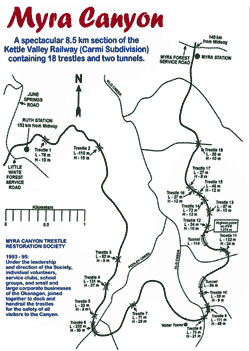 Travelling westbound from the zero marker near the parking lot (That's railway westbound. The KVR runs east and west between Midway and Hope. Geographically, the route actually heads south from this point.) along the route the grade descends imperceptably from Myra to Ruth. It's a short bicycle ride before you first enter the canyon and immediately see trestles on the opposite side. Tracing the route with your eyes you can see the right-of-way makes a line south into Myra Canyon losing elevation slightly on its descent towards Ruth, Chute Lake, and eventually Penticton. Don't be intimidated by the length of the bike ride you see before you, the kilometers pass very quickly along the trail.
Travelling westbound from the zero marker near the parking lot (That's railway westbound. The KVR runs east and west between Midway and Hope. Geographically, the route actually heads south from this point.) along the route the grade descends imperceptably from Myra to Ruth. It's a short bicycle ride before you first enter the canyon and immediately see trestles on the opposite side. Tracing the route with your eyes you can see the right-of-way makes a line south into Myra Canyon losing elevation slightly on its descent towards Ruth, Chute Lake, and eventually Penticton. Don't be intimidated by the length of the bike ride you see before you, the kilometers pass very quickly along the trail.
The route crosses 18 trestles that are numbered from west to east. The majority are timber construction, but there are steel structures too. Two short rock tunnels create cool shade on hot summer days. The eastern-most tunnel has been reinforced with new timber cribbing to support crumbling overhead granite.
The most impressive bridge on the route has to be the West Fork Canyon steel trestle located slightly past the halfway mark. It is a huge curving structure built 55 meters high over the western fork of the canyon.
There is a trestle bypass over the original 1914 trestle located between trestles 2 and 3. The railbed was relocated across a slide path leaving the remains of the original trestle below with its top two tiers removed.
Small signs describe points of interest along the way. Look carefully and you will spot old water tank footings, rotten log cribbed retaining walls, stone retaining walls constructed without mortar, and abandoned building foundations.
Ruth Station which was named for one of Andrew McCulloch's daughters is now a heap of rotting boards over a concrete foundation. The site lies at the end of Myra Canyon just past the 12 kilometer point. A Richardson ground squirrel is the only remaining inhabitant at the station.
CP 136 is a 4-4-0 Standard (or American) Class A2m steam locomotive. One of only six similar engines still remaining today and one of only two still operative. She may be found at the South Simcoe Railway located near Tottenham, Ontario. The other operative 4-4-0,
CP 133, now runs as Prairie Dog Central number 3 near Winnipeg. The other three inoperative examples are CP 29, inoperative due to an enginehouse fire, but cosmetically restored and now displayed at Canadian Pacific's Ogen Yard in Calgary, Alberta, CP 144 located inside the Expo Rail Museum at St. Constant, Quebec, and CP 374 found at Yaletown in Vancouver, British Columbia, on display at what remains of the old Drake Street Roundhouse, now a community center. And finally, although lettered C.P.R. No 1 and named Countess of Dufferin it is not that railway's number one as the Canadian Pacific Railway Company wasn't incorporated until 1881 while this locomotive was already working at Winnipeg in 1877. The "Countess of Dufferin" is presently stored at the Winnipeg Railway Museum in the VIA Rail station. CP's number 1 locomotive was built by the Portland Company at Portland, Maine, in August of 1881 with builders number 391. CP 1 was scrapped in April 1912.
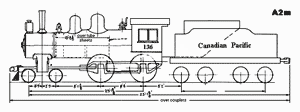
Manufacturer ............. Rogers Locomotive Co. Patterson NJ USA
Built .................... 1883
Serial number ............ 3332
Boiler pressure .......... 160 psi
Cylinders ................ 17 x 24 inches
Drivers .................. 63 inches
Tractive effort .......... 15,000 pounds
Fuel ..................... Coal
Weight on drivers ........ 65,000 pounds
Loaded Weight ............ 100,000 pounds
The Canadian Pacific Railway utilized four numbering series for its steam locomotives over the years. Omer Lavallee called these groups; Series I, Series II, Series IIa, and Series III. Series I included engines from 1881 to 1908. Series II began in 1905. Series IIa had a false start in 1912 and contained only 48 locomotives. Series III was put in place between 1912 and 1914 and was the last major renumbering of CP steam locomotives. As engines were rebuilt, upgraded, or scrapped during their lifetimes they may have passed through several renumberings. This is a complex subject. You should refer to Omer Lavallee's book titled "Canadian Pacific Steam Locomotives" published in 1985 for detailed information.
Today's Number 136 began life in 1883 at the Rogers Locomotive Company in Patterson, New Jersey, USA. She had builders number 3332 and was constructed as a 4-4-0 type commonly known as an "American" in America but called a "Standard" here in Canada. There were no class numbers at that time. Seventeen by twenty-four inch cylinders pushed sixty-two inch driving wheels. In May of 1907 the driving wheel diameter was increased to sixty-three inches and the engine renumbered 196 in Series II. She was class A5h at that time. A second renumbering occurred in September 1912 into Series IIa as number 115. Finally, in August 1913 she became 136, an A2m class steam locomotive. The CP disposed of her in 1960 to one Neil McNish, somehow ending up in the possession of the Ontario Rail Association and today the South Simcoe Railway at Tottenham, Ontario.
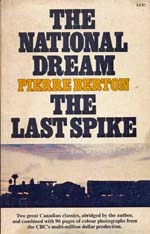 Number 136 was used in the making of the Canadian Broadcasting Corporation (CBC) television mini-series named the National Dream in 1973. She was modified to an older appearance and renumbered 144 for several scenes. Here's an interesting anecdote from that filming:
Number 136 was used in the making of the Canadian Broadcasting Corporation (CBC) television mini-series named the National Dream in 1973. She was modified to an older appearance and renumbered 144 for several scenes. Here's an interesting anecdote from that filming:
In one particular scene the locomotive pulls a train of soldiers from the East to crush the Riel Rebelion out West. The train reaches a gap in the incomplete main line near Lake Superior where the soldiers must disembark to march across an ice and snow filled gap to reach the next section of operational track. They then board a train pulled by the same engine! The film company obviously neglected to renumber the engine between scenes.
This circumstance came about due to the CBC's request to ship the locomotive complete with a special non-glare paint job and no numbers for the non-winter footage shot in Alberta and British Columbia during June. Numbers were applied using vinyl and changed as required. During 136's return to Toronto she was used for a double-headed fan trip with Number 1057 to Owen Sound in October. Her number 136 was painted on for that trip.
The winter scenes were then shot in December on the Nephton Subdivision north of Havelock in an uncharacteristic early blast of snow and extreme cold. CBC was informed of the painted numbers but it wasn't until they were about to shoot the first winter scene that it sunk in. With the large production crew, including Pierre Berton, already on hand they had little choice but to go ahead and shoot with the painted numbers. However, they did paint out the number on the smokebox and you may notice it is blank in the winter footage.
7 June 2003 - Some corrections to the above text were supplied by Joe Smuin.
5 Sep 2003 - Fire Devours Beloved B.C. Trestles
27 Aug 2004 - B.C. Railway Trestles to be Rebuilt
2 Sep 2004 - Trestle for Christmas
29 Oct 2004 - First Kettle Valley Trestle Rebuild Contract Awarded
27 Nov 2004 - Work Begins on Trestles
17 Dec 2004 - Trestle Restoration Project Begins
Fall 2008 - Historic Myra Canyon Trestles Restored in the Okanagan
15 Dec 2008 - Myra's Men - Building the Kettle Valley Railway Myra Canyon to Penticton
16 Jul 2009 - Dig Some Local History Myra Canyon Style
7 Aug 2010 - Myra Canyon an Icon of Canadian Railroad History
2 Apr 2011 - Kettle Valley Railway's History Chronicled on DVD
10 Apr 2013 - Myra Canyon Closed to the Public
13 Arp 2017 - Bike the Kettle Valley Railway
20 Mar 2018 - MCTRS Celebrates 25 Years With New Website
6 Apr 2018 - An Update on the MCTRS with a Little History
28 Jun 2018 - More Than 700 Cyclists Will Participate in Okanagan Trestles Tour
Myra Canyon Trestle Restoration Society (Link fails 19 Dec 2022)
Myra Canyon Section National Historic Site
South Simcoe Railway
Canadian Pacific Historical Association
Brookmere and the Kettle Valley Railway
Max Jacquiard Myra Canyon Print
Kettle Valley Brakemen
Kettle Valley Winery
Touring the Kettle Valley Railway
The Great Trail (Link fails 11 Jul 2022)
 Quintette Tunnels on the Coquihalla Subdivision of the Abandoned Kettle Valley Railway, TheBrown, Kevin M.1981Government of British Columbia Parliament Buildings Victoria BC V8V 1X4.Cerlox bound.8.5 x 11 in - 21.5 x 28 cm - 206 pages.Description of condition as of 1981 with some history and construction photos. Proposal to either preserve tunnels as heritage site with interpretive center or relay track and run steam train excursions. Direct access from Coquihalla Highway would be denied by Ministry of Highways.
Quintette Tunnels on the Coquihalla Subdivision of the Abandoned Kettle Valley Railway, TheBrown, Kevin M.1981Government of British Columbia Parliament Buildings Victoria BC V8V 1X4.Cerlox bound.8.5 x 11 in - 21.5 x 28 cm - 206 pages.Description of condition as of 1981 with some history and construction photos. Proposal to either preserve tunnels as heritage site with interpretive center or relay track and run steam train excursions. Direct access from Coquihalla Highway would be denied by Ministry of Highways. National Dream, TheBerton, Pierre1970McClelland & Stewart 900-481 University Ave. Toronto ON M5G 2E9.Hard cover.6.5 x 9.75 in - 17 x 25 cm - 439 pages.Politics during the construction of the CPR.
National Dream, TheBerton, Pierre1970McClelland & Stewart 900-481 University Ave. Toronto ON M5G 2E9.Hard cover.6.5 x 9.75 in - 17 x 25 cm - 439 pages.Politics during the construction of the CPR. Last Spike, TheBerton, Pierre1971McClelland & Stewart 900-481 University Ave. Toronto ON M5G 2E9.Hard cover.6.5 x 9.75 in - 17 x 25 cm - 478 pages.Politics during the construction of the CPR.
Last Spike, TheBerton, Pierre1971McClelland & Stewart 900-481 University Ave. Toronto ON M5G 2E9.Hard cover.6.5 x 9.75 in - 17 x 25 cm - 478 pages.Politics during the construction of the CPR. Great Railway Illustrated, TheBerton, Pierre1972McClelland & Stewart 900-481 University Ave. Toronto ON M5G 2E9.Hard cover.10 x 10.25 in - 25.5 x 26 cm - 336 pages.Historic photos taken during CPR construction.
Great Railway Illustrated, TheBerton, Pierre1972McClelland & Stewart 900-481 University Ave. Toronto ON M5G 2E9.Hard cover.10 x 10.25 in - 25.5 x 26 cm - 336 pages.Historic photos taken during CPR construction. Kettle Valley Railway Volume 1Doeksen, G.1981W.A.V.E.S. Box 165 Montrose BC V0G 1P0.Stapled.8.5 x 11 in - 21.5 x 28 cm - 32 pages.Collection of author's ink drawings.
Kettle Valley Railway Volume 1Doeksen, G.1981W.A.V.E.S. Box 165 Montrose BC V0G 1P0.Stapled.8.5 x 11 in - 21.5 x 28 cm - 32 pages.Collection of author's ink drawings. Railways of the West Kootenay Volume 2Doeksen, G.1983W.A.V.E.S. Box 165 Montrose BC V0G 1P0.Stapled.8.5 x 11 in - 21.5 x 28 cm - 36 pages.Photos and captions.
Railways of the West Kootenay Volume 2Doeksen, G.1983W.A.V.E.S. Box 165 Montrose BC V0G 1P0.Stapled.8.5 x 11 in - 21.5 x 28 cm - 36 pages.Photos and captions. Railways of the West Kootenay Part 2Doeksen, G.1984W.A.V.E.S. Box 165 Montrose BC V0G 1P0.Stapled.8.5 x 11 in - 21.5 x 28 cm - 40 pages.Photos and captions.
Railways of the West Kootenay Part 2Doeksen, G.1984W.A.V.E.S. Box 165 Montrose BC V0G 1P0.Stapled.8.5 x 11 in - 21.5 x 28 cm - 40 pages.Photos and captions. Report of Mr. R.C. Clute on the Commission to Inquire into the Death of McDonald and Fraser on the Crow's Nest Pass RailwayGovernment of Canada1899Government of Canada Parliament Buildings Ottawa ON.Stapled.9.75 in - 16.5 x 24.5 cm - 17 pages.Excellent report details unnecessary deaths of two labourers and shows working conditions on the Crowsnest Pass railway in 1899.
Report of Mr. R.C. Clute on the Commission to Inquire into the Death of McDonald and Fraser on the Crow's Nest Pass RailwayGovernment of Canada1899Government of Canada Parliament Buildings Ottawa ON.Stapled.9.75 in - 16.5 x 24.5 cm - 17 pages.Excellent report details unnecessary deaths of two labourers and shows working conditions on the Crowsnest Pass railway in 1899. Report of the Commissioners Appointed to Inquire into Complaints Respecting the Treatment of Labourers on the Crow's Nest Pass RailwayGovernment of Canada1899Government of Canada Parliament Buildings Ottawa ON.Stapled.6.5 x 9.75 in - 16.5 x 24.5 cm - 23 pages.Excellent description of hardships endured by construction workers on the Crowsnest Pass railway.
Report of the Commissioners Appointed to Inquire into Complaints Respecting the Treatment of Labourers on the Crow's Nest Pass RailwayGovernment of Canada1899Government of Canada Parliament Buildings Ottawa ON.Stapled.6.5 x 9.75 in - 16.5 x 24.5 cm - 23 pages.Excellent description of hardships endured by construction workers on the Crowsnest Pass railway.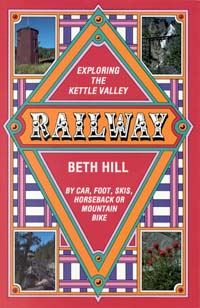 Exploring the Kettle Valley Railway: By Car, Foot, Skis, Horseback or Mountain BikeHill, Beth1989Polestar Press Ltd. RR 1 Winlaw BC V0G 2J0.Perfect bound.5.5 x 8.5 in - 14 x 21.5 cm - 108 pages.The book describes Kettle Valley Railway route in its abandoned condition in 1989.
Exploring the Kettle Valley Railway: By Car, Foot, Skis, Horseback or Mountain BikeHill, Beth1989Polestar Press Ltd. RR 1 Winlaw BC V0G 2J0.Perfect bound.5.5 x 8.5 in - 14 x 21.5 cm - 108 pages.The book describes Kettle Valley Railway route in its abandoned condition in 1989.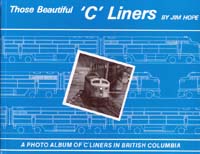 Those Beautiful "C" LinersHope, Jim1979Launch Pad Distributors Publishing 7043 Dumphries St. Vancouver BC V5P 3C3.Soft cover.8 x 11 in - 20.5 x 28 cm - 44 pages.Photos and captions.
Those Beautiful "C" LinersHope, Jim1979Launch Pad Distributors Publishing 7043 Dumphries St. Vancouver BC V5P 3C3.Soft cover.8 x 11 in - 20.5 x 28 cm - 44 pages.Photos and captions.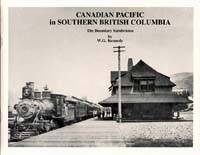 Canadian Pacific in Southern British Columbia the Boundry DivisionKennedy, W.G.1986British Railway Modellers of North America 5124-33rd St. Northwest Calgary AB T2L 1V4.Stapled.11 x 8.5 in - 28 x 21.5 cm - 30 pages.Photos and captions. "Gib" Kennedy was a recognized authority on Canadian Pacific locomotives and rolling stock and a regular contributor on this subject to Model Railroader magazine. Not only did he build the equipment in many cases, but he prepared scale blueprints as well. His specialty was HO gauge.
Canadian Pacific in Southern British Columbia the Boundry DivisionKennedy, W.G.1986British Railway Modellers of North America 5124-33rd St. Northwest Calgary AB T2L 1V4.Stapled.11 x 8.5 in - 28 x 21.5 cm - 30 pages.Photos and captions. "Gib" Kennedy was a recognized authority on Canadian Pacific locomotives and rolling stock and a regular contributor on this subject to Model Railroader magazine. Not only did he build the equipment in many cases, but he prepared scale blueprints as well. His specialty was HO gauge.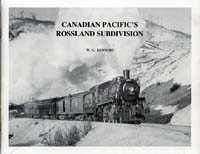 Canadian Pacific's Rossland SubdivisionKennedy, W.G.1986British Railway Modellers of North America 5124-33rd St. Northwest Calgary AB T2L 1V4.Stapled.11 x 8.5 in - 28 x 21.5 cm - 26 pages.Photos and captions.
Canadian Pacific's Rossland SubdivisionKennedy, W.G.1986British Railway Modellers of North America 5124-33rd St. Northwest Calgary AB T2L 1V4.Stapled.11 x 8.5 in - 28 x 21.5 cm - 26 pages.Photos and captions.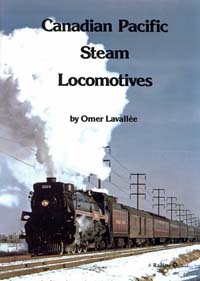 Canadian Pacific Steam LocomotivesLavallee, Omer1985Railfare Enterprises Ltd. Box 33 West Hill Toronto ON M1E 4R4.Hard cover.9 x 12 in - 28 x 21.5 cm - 464 pages.Excellent work, very comprehensive defining steam locomotive fleet from beginning to end. Oversize book.
Canadian Pacific Steam LocomotivesLavallee, Omer1985Railfare Enterprises Ltd. Box 33 West Hill Toronto ON M1E 4R4.Hard cover.9 x 12 in - 28 x 21.5 cm - 464 pages.Excellent work, very comprehensive defining steam locomotive fleet from beginning to end. Oversize book. Vader's Caboose, TheMatheson, George1994Kettle Valley Publishing Inc. RR 2 Site 2 Comp 19 Lumby BC V0E 2G0.Perfect bound.6 x 9 in - 15 x 23 cm - 223 pages.Somewhat gritty short stories about life and the Kettle Valley Railway.
Vader's Caboose, TheMatheson, George1994Kettle Valley Publishing Inc. RR 2 Site 2 Comp 19 Lumby BC V0E 2G0.Perfect bound.6 x 9 in - 15 x 23 cm - 223 pages.Somewhat gritty short stories about life and the Kettle Valley Railway.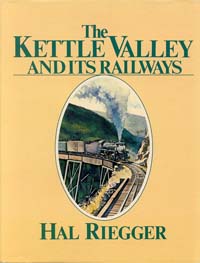 Kettle Valley and its Railways, TheRiegger, Hal1981Pacific Fast Mail Publications PO Box 57 Edmonds WA USA 98020.Hard cover.8.75 x 11.25 in - 22 x 28.5 cm - 289 pages.Excellent coverage of Southern BC operations. Errors in publication corrected by the late David Wilkie. Oversize book.
Kettle Valley and its Railways, TheRiegger, Hal1981Pacific Fast Mail Publications PO Box 57 Edmonds WA USA 98020.Hard cover.8.75 x 11.25 in - 22 x 28.5 cm - 289 pages.Excellent coverage of Southern BC operations. Errors in publication corrected by the late David Wilkie. Oversize book.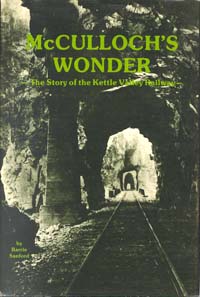 McCulloch's WonderSanford, Barrie1977Whitecap Books Ltd. 351 Lynn Ave. North Vancouver BC V7J 2C4.Hard cover.6.25 x 9.25 in - 16 x 23.5 cm - 260 pages.Construction of the Kettle Valley route.
McCulloch's WonderSanford, Barrie1977Whitecap Books Ltd. 351 Lynn Ave. North Vancouver BC V7J 2C4.Hard cover.6.25 x 9.25 in - 16 x 23.5 cm - 260 pages.Construction of the Kettle Valley route.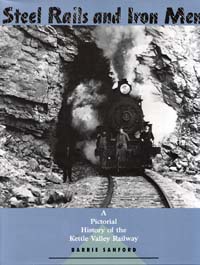 Steel Rails and Iron MenSanford, Barrie1990Whitecap Books Ltd. 351 Lynn Ave. North Vancouver BC V7J 2C4.Hard cover.9 x 11.5 in - 23 x 28.5 cm - 165 pages.Excellent photo book written by the author of "McCulloch's Wonder" is a pictorial history (more than 150 original photos). A mile-by-mile story of the birth, life, and death of a railway.
Steel Rails and Iron MenSanford, Barrie1990Whitecap Books Ltd. 351 Lynn Ave. North Vancouver BC V7J 2C4.Hard cover.9 x 11.5 in - 23 x 28.5 cm - 165 pages.Excellent photo book written by the author of "McCulloch's Wonder" is a pictorial history (more than 150 original photos). A mile-by-mile story of the birth, life, and death of a railway.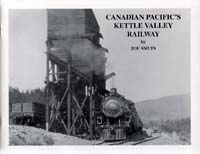 Canadian Pacific's Kettle Valley RailwaySmuin, Joe1997Canadian Railroad Historical Association 120 Rue St. Pierre St. Constant PQ J5A 2G9.Stapled.11 x 8.5 in - 28 x 21.5 cm - 36 pages.Photos and captions.
Canadian Pacific's Kettle Valley RailwaySmuin, Joe1997Canadian Railroad Historical Association 120 Rue St. Pierre St. Constant PQ J5A 2G9.Stapled.11 x 8.5 in - 28 x 21.5 cm - 36 pages.Photos and captions.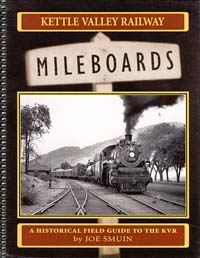 Kettle Valley Railway Mileboards - A Historical Field Guide to the KVRSmuin, Joe2003North Kildonan Publications Box 99 Stn F 355 Henderson Highway Winnipeg MB R2L 2A5.Plastic spiral bound.8.5 x 11 in - 21.5 x 28 cm - 212 pages.Plus 6 graphs and 3 timetables. All photos are black and white. This book details the physical layout of the KVR with a certain amount of pertinent historical detail added. The book is reminiscent of Roger Burrows two "Railway Mileposts British Columbia" books.
Kettle Valley Railway Mileboards - A Historical Field Guide to the KVRSmuin, Joe2003North Kildonan Publications Box 99 Stn F 355 Henderson Highway Winnipeg MB R2L 2A5.Plastic spiral bound.8.5 x 11 in - 21.5 x 28 cm - 212 pages.Plus 6 graphs and 3 timetables. All photos are black and white. This book details the physical layout of the KVR with a certain amount of pertinent historical detail added. The book is reminiscent of Roger Burrows two "Railway Mileposts British Columbia" books.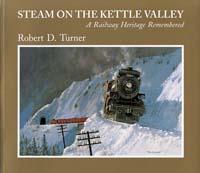 Steam on the Kettle ValleyTurner, Robert D.1995Sono Nis Press 1745 Blanshard St. Victoria BC V8W 2J8.Perfect bound.9 x 7.75 in - 22.5 x 19.5 cm - 120 pages.Contains previously unpublished photos.
Steam on the Kettle ValleyTurner, Robert D.1995Sono Nis Press 1745 Blanshard St. Victoria BC V8W 2J8.Perfect bound.9 x 7.75 in - 22.5 x 19.5 cm - 120 pages.Contains previously unpublished photos.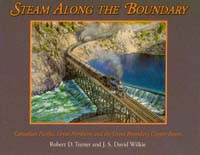 Steam Along the BoundaryTurner, Robert D.2007Sono Nis Press 1745 Blanshard St. Victoria BC V8W 2J8.Hard cover.11 x 9 in - 28 x 23 cm - 224 pages.Co-author Wilkie, David. British Columbia's railway and mining history. The great copper boom that seized the Boundary District in the late 1890s and early 1900s. The rival Great Northern and Canadian Pacific railways, along with the fledgling Kettle River Valley Railway, were the major players in a fierce competition for the rich ores and copper wealth of the region.
Steam Along the BoundaryTurner, Robert D.2007Sono Nis Press 1745 Blanshard St. Victoria BC V8W 2J8.Hard cover.11 x 9 in - 28 x 23 cm - 224 pages.Co-author Wilkie, David. British Columbia's railway and mining history. The great copper boom that seized the Boundary District in the late 1890s and early 1900s. The rival Great Northern and Canadian Pacific railways, along with the fledgling Kettle River Valley Railway, were the major players in a fierce competition for the rich ores and copper wealth of the region.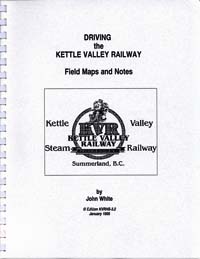 Driving the Kettle Valley Railway Field Maps and NotesWhite, John1995Publisher unknown.Spiral bound.8.5 x 11 in - 21.5 x 28 cm - 282 pages.Mainly topographical maps of Kettle Valley route plus crudely drawn maps by author.
Driving the Kettle Valley Railway Field Maps and NotesWhite, John1995Publisher unknown.Spiral bound.8.5 x 11 in - 21.5 x 28 cm - 282 pages.Mainly topographical maps of Kettle Valley route plus crudely drawn maps by author.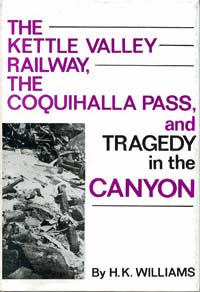 Kettle Valley Railway, the Coquihalla Pass, and Tragedy in the Canyon, TheWilliams, H.K.1989Carleton Press Inc. New York NY USA.Hard cover.5.5 x 8.25 in - 14 x 20.5 cm - 32 pages.A wreck that occurred 5 September 1926 in the Coquihalla Canyon.
Kettle Valley Railway, the Coquihalla Pass, and Tragedy in the Canyon, TheWilliams, H.K.1989Carleton Press Inc. New York NY USA.Hard cover.5.5 x 8.25 in - 14 x 20.5 cm - 32 pages.A wreck that occurred 5 September 1926 in the Coquihalla Canyon.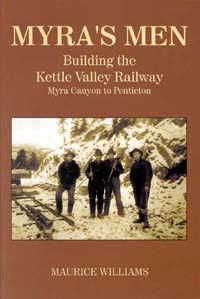 Myra's MenWilliams, Maurice2008Myra Canyon Trestle Restoration Society Sandhill Book Marketing Ltd. Unit 4-3308 Appaloosa Road Millcreek Industrial Park Kelowna BC V1V 2G9.Soft cover.6 x 9 in - 15.25 x 22.75 cm - 168 pages.An overall description of the Kettle Valley Railway with emphasis on Myra Canyon plus a description of the labourers and construction camp life.
Myra's MenWilliams, Maurice2008Myra Canyon Trestle Restoration Society Sandhill Book Marketing Ltd. Unit 4-3308 Appaloosa Road Millcreek Industrial Park Kelowna BC V1V 2G9.Soft cover.6 x 9 in - 15.25 x 22.75 cm - 168 pages.An overall description of the Kettle Valley Railway with emphasis on Myra Canyon plus a description of the labourers and construction camp life.
